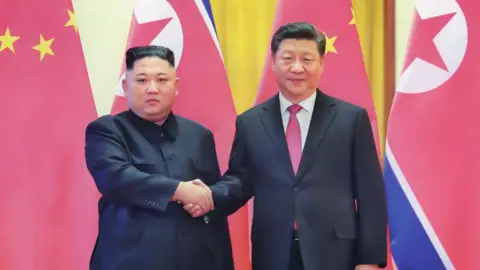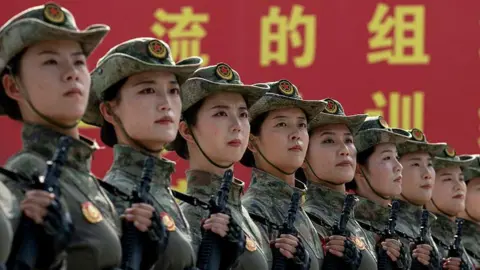China correspondent
Seoul correspondent
 Getty Images
Getty ImagesNorth Korea’s leader Kim Jong Un will attend a military parade in Beijing next week alongside Russia’s Vladimir Putin, China’s foreign ministry has said, in what will be a landmark visit.
This comes days after US President Donald Trump said he wanted to meet Kim who rarely makes foreign visits, and as the White House tries to broker a deal to end the war in Ukraine.
China’s “Victory Day” parade on 3 September will mark the 80th anniversary of Japan’s formal surrender in World War Two and the end of the conflict.
The event now signals a key diplomatic win for Chinese leader Xi Jinping who has been pushing for a new world order led by Beijing.
Putin and Kim will be among 26 other heads of state who are expected to attend the parade.
China is likely to display its latest weaponry, including hundreds of aircraft, tanks and anti-drone systems. This will be the first time its military’s new force structure is being fully showcased in a parade.
The highly choreographed event will see tens of thousands of military personnel march in formation through the historic Tiananmen Square, with troops from 45 of the so-called echelons of China’s military as well as war veterans.
The 70-minute parade, which will be surveyed by Xi, is expected to be closely watched by analysts and western powers.
In a press conference given by China’s foreign ministry on Thursday, Beijing – one of Pyongyang’s closest allies – praised its neighbour for their decades-long “traditional friendship” and said the two countries will continue to collaborate on “regional peace and stability”.
Kim’s attendance is an upgrade from China’s last Victory Day parade in 2015, when Pyongyang sent one of its top officials, Choe Ryong-hae.
This year’s event where Kim will be standing alongside Putin and Xi will be significant beyond the photo-op.
The surprise meeting will happen even as Donald Trump attempts to make a deal with Moscow to end the war in Ukraine. This allows Xi to signal his influence – although limited – on both Putin and Kim.
It is also just weeks before a possible visit by Trump to Asia, which the White House has hinted at but not confirmed. It has, however, said the US President is open to meeting Xi to finalise a tariffs deal, among other things.
Next week’s meeting with Putin and Kim allows Xi to walk into any summit with Trump with more confidence, having been fully briefed by both leaders.
It’s been six years since Kim visited Beijing – he last attended an event to mark the 70th anniversary of diplomatic ties between the two countries in 2019.
He also visited Beijing three times in 2018, a particularly busy year for international trips given his reluctance to travel abroad.
 AFP via Getty Images
AFP via Getty ImagesMost Western leaders are not expected to attend the parade, due to their opposition to Russia’s invasion of Ukraine, which has driven the sanctions against Putin’s regime.
Beijing, however, has not criticised Putin’s war and has been accused by the US and its allies of even aiding it – which it denies. Kim, on the other hand, has supplied both weapons and troops to the Russian invasion.
There is now the question of whether South Korea’s new president, Lee Jae Myung, will attend the parade, thereby providing the first opportunity for the leaders of North and South Korea to meet since relations broke down in 2019.
Lee has been invited, but has not accepted the invitation. South Korea’s presidential office has not commented on this yet. The government has so far only confirmed that the speaker of the parliament will be attending.
Lee, who was elected in June, has repeatedly said he would like to speak to Kim Jong Un and establish peaceful relations with the North. On Monday, when Lee met President Trump in the Oval Office, he asked Trump to act as a peacemaker on the Korean peninsula. Lee has also stated he wants to strengthen ties with Beijing.
But North Korea has repeatedly criticised Lee, rejecting all his attempts to engage. Just yesterday its state news agency, KCNA, labelled Lee “a confrontational maniac”.
While attending the parade would get Lee physically close to Kim, it is a risky move. If Kim publicly ignores or rebuffs the South Korean leader, it would be a major embarrassment.
The optics of Lee appearing next to the presidents of Russia, Belarus and Iran is also something South Korea may want to avoid.
The list of leaders attending the parade also reflects China’s rise and its changing relationship with the world.
The Indonesia president and Malaysian prime minister will be there, which is further proof of Beijing’s concerted efforts to ramp up ties with neighbouring South East Asia. Others like Singapore are sending lower- level representatives.
Myanmar’s military ruler Min Aung Hliang, an international pariah who is hugely dependent on Chinese trade and aid, will also be attending.
There will be fewer European Union officials, with just one EU leader attending – Slovak Prime Minister Robert Fico – while Bulgaria and Hungary will send representatives.
In contrast, Czech President Milos Zeman attended the 2015 parade, while Poland, France, Hungary, Italy, the Netherlands, and the UK sent parliamentary speakers or government envoys to the parade.
Additional reporting by Ian Tang from BBC Monitoring

